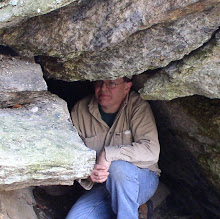
Devil's Washboard
Over the previous winter it was decided to spend time in and around northern Franklin County to mostly revisit old sites for the purpose of furthering my knowledge on the area. Continuing on with this I ended up in the most northeastern section of that County. It is mostly covered by the old Mt. Grace geologic quadrangle, first Massachusetts bedrock geologic map in the USGS GQ series. This "quad", and adjacent areas to its immediate west, cover a wide spectrum of interesting features. Among these are a few caves, a tipping rock, a Wabeek boulder, a chamber, old iron ore and potash mining sites, Indian Kettles, and - my first stop - the Devil's Washboard.
The Washboard is now accessible thanks to the Mount Grace Land Conservation Trust . On the hike in, a small miniature chasm carved in the streambed could be observed just off the trail above the crossing of the brook and wetlands. Eventually this trail ends above Devil's Washboard and it's up to the hiker to pick his way down to stream side. However, one is rewarded with a wonderful waterfall dropping its way down through a natural basin. The whole area, especially upstream, is a picturesque chasm with rock walls. Also just upstream is a 'grotto' or schistose den eroded away in the ledges.
Some years ago I visited the Indian Kettles and thought I'd give it a go at accessing them from a different direction. Although unsuccessful, some of my best finds come almost by accident. I passed by a couple old cellar holes still in fine condition. One has interior partitions (some have called 'chambers') and I've been told it was an old tavern. Beyond was a marvelous set of waterfalls heretofore unknown to myself.


